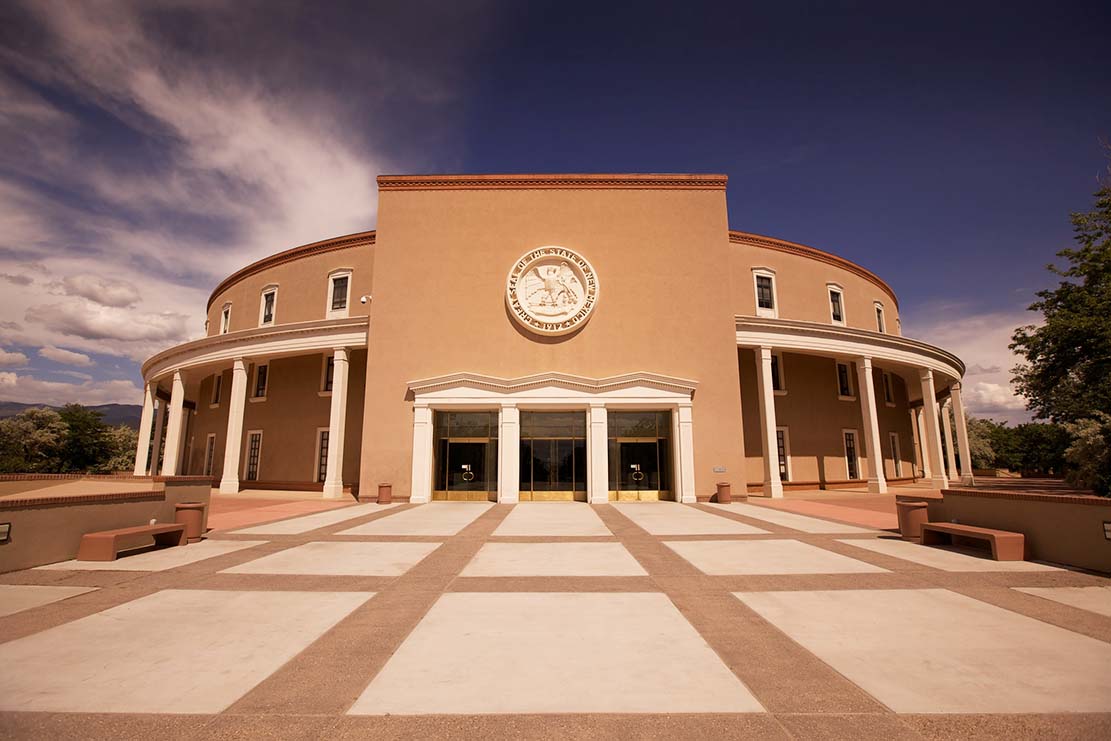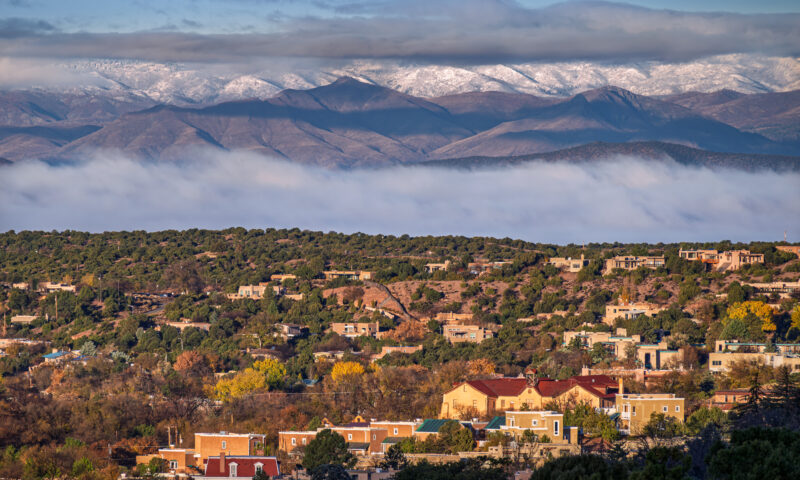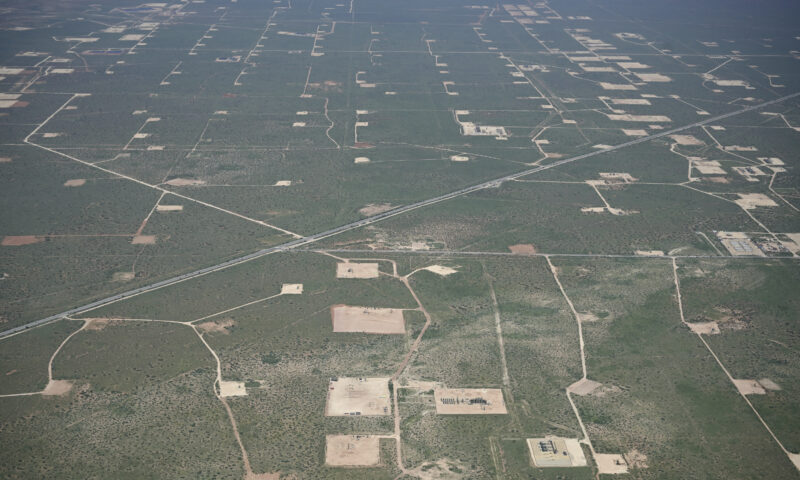The Slick
Funding for Greenhouse Gas Regulation in Danger Despite Huge New Mexico Budget Surplus
While the state is flush with record fossil fuel revenues, key legislators oppose full funding of state agencies that police the industry.

New Mexico’s legislators headed back to Santa Fe this week for their biannual legislative session devoted to state funding. And roughly 40% of all debate will be about the state’s oil and gas industry, whether legislators say so or not.
That’s because the fossil fuel industry has gone gangbusters in the past 12 months, and income from that sector will make up about 40% of the state’s general fund revenues.
Join our email list to get the stories that mainstream news is overlooking.
Sign up for Capital & Main’s newsletter.
In her state of the state speech on opening day of the legislative session on Tuesday, Gov. Michelle Lujan Grisham said, “We have, right now, unimaginable financial resources at our disposal.”
The governor’s unimaginable financial resources are actually a rise in the state’s budget of about $1 billion, up 13% over last year’s budget, with almost all of that coming from increased oil and gas revenues.
Yet, some legislators seem reluctant to use that money to fund the two state agencies that monitor oil and gas operators and are trying to rein in the industry’s greenhouse gas emissions.
Sen. George Muñoz is a conservative Democrat whose district wraps through the state’s coal belt and into its northern natural gas fields. He’s not the only conservative on the powerful Legislative Finance Committee (LFC) — there are several noisy right-wing Republicans as well — but he is the vice chair. And at a Senate Finance Committee meeting in mid-January he said, “We may have to change the shape of the capital because everybody thinks it’s a feed trough.”
Some legislators seem reluctant to use the budget surplus to fund the two state agencies that monitor oil and gas operators.
Minutes before, New Mexico Environment Department (NMED) Secretary James Kenney defended his agency’s request for large funding increases to implement new oilfield monitoring programs and to stand up a new Climate Change Bureau, among other things.
The LFC recommendation had slashed the department’s budget request.
Kenney said, “We simply can’t do these. We can’t do these items” under the LFC funding proposal.
“I would rather succeed by not doing it than fail by getting partial funding,” he said.
When Kenney finished, Muñoz said, “You were the prize winner around the feed trough last year when [NMED] got a 17% increase.”
The department’s 16 different bureaus monitor air pollution from (among other things) oil and gas operations, as well as the state’s nuclear waste repository, public swimming pools, workplace response to COVID-19, food safety, sewer projects and more.
This year, NMED asked for $23 million from the state general fund. LFC offered $17 million, a 6.4% budget increase from last year.
The budgets for the Oil Conservation Division (OCD) and NMED make up just a small sliver of the Governor’s budget proposal — far out of proportion to the industry’s threats to the environment.
Muñoz then chastised Kenney for his PowerPoint presentation in which LFC budget recommendations were crossed out in red. “Remind me to get that Sharpie … taken away from you,” he said.
The session ended minutes later with some strained banter between the two about tofu burgers for dinner, but when asked about the exchange the next day, Kenney said, “It does not appear the LFC considers climate change a priority.”
This is not where the state’s chief executive wants to be. At her state of the state address, Gov. Lujan Grisham said, “I know there is a temptation to view today as the opening kickoff of a big game, or the launch of some great battle. … This isn’t the sports page.”
But that game has already begun.
* * *
On one side of the playing field are state departments and their budget requests, laid out in the Executive Recommendation drawn up by the governor’s office. On the other side is the LFC and its own budget recommendations. The football in the middle of this game consists of the budgets for the two state agencies that monitor and rule over the state’s lucrative oil and gas industry.
Those budgets for the state’s Oil Conservation Division (OCD) and NMED make up just a small sliver of either the LFC or the Governor’s budget proposal — far out of proportion to the industry’s threats to the state’s environment and climate.
Legislators simply have to walk out of the capitol building to see that result: temperatures across the state are running 10 degrees above average, and snowpack in nine of 13 basins that hold New Mexico’s water are well below average, this atop years of drought. A recently released report from NOAA highlights these problems and says they are likely to worsen in coming years.
“If you’re the executive then you can do anything by rulemaking and by executive order. But is that the right process?”
~ New Mexico State Sen. George Muñoz
In the end, the one group that benefits from this fight is the oil and gas industry itself, which gets free publicity for the news of its contribution to the state budget, and may well end up with weakened enforcement of its actions in the oil and gas fields.
Part of the impending fight comes from the unpredictable nature of fossil fuel industry revenues.
Talking after the finance committee meeting, Muñoz said, “We ride the roller coaster every time with oil and gas revenues.” He’s concerned about funding new programs with unstable money sources and calls this year’s budget surplus “crazy to kind of outrageous. I’ve never seen this kind of money before.”
He’s also clearly annoyed by how the new greenhouse gas monitoring rules came about — as part of a public rule-making process rather than a legislative bill.
“If you’re the executive then you can do anything by rulemaking and by executive order” rather than by making laws in the legislature, he said. “But is that the right process?”
* * *
In a way, the legislative season started weeks before most lawmakers arrived in Santa Fe from around the state, with the governor’s office announcing its recommendations, followed by the LFC budget proposal. Most of this session will be spent debating the two and eventually agreeing on a budget that the agencies have to make work.
The OCD and NMED budget fight between the Office of the Governor and the LFC is over a minute amount of the state budget — about 0.44% of the $8.46 billion LFC recommendation, even as the number of new wells continues to rise and recent reporting changes indicate for the first time the extraordinary amount of greenhouse gasses the industry is releasing across the state.
But that money is inherently important and controversial: It involves the state’s response to climate change by trying to monitor and contain damage from the oil and gas industry.
And what the state does with that minute amount has an outsized role in the planet’s future.
The recent production increases that boosted the state’s budget would also make New Mexico one of the world’s top-20 oil producers, if it were a sovereign country. At the same time, the industry pulling that oil from the ground creates 53% of the state’s total greenhouse gas emissions all by itself.
Surprisingly, Lujan Grisham made no mention of climate change or its challenges in her 2022 State of the State address that kicked off the legislative session. But she has prioritized reducing greenhouse gasses as a main goal of her administration. And just recently, she announced a statewide goal to reduce greenhouse gas emissions by 50% by 2030.
“It will be difficult to keep up if the current LFC budget is approved. It will be increasingly hard to tackle backlogs and keep up with an increasingly complex industry.”
~ Adrienne Sandoval, director, Oil Conservation Division
At her direction, NMED and OCD have written and implemented new rules designed to dramatically reduce spills, leaks and pollution around oil and gas operations. To help fund those initiatives, the governor requested an additional $2.57 million for OCD this year, mostly to hire more people and acquire technology to monitor the state’s more than 52,000 active oil and gas wells.
The LFC responded with a $511,000 bump.
That slight budget increase comes in spite of the division implementing the biggest increase in monitoring and oversight in years, which has revealed both the monumental scope of the industry’s environmental spills and the companies that are — and aren’t — reporting them.
“It will be difficult to keep up if the current LFC budget is approved,” says Adrienne Sandoval, OCD director. “It will be increasingly hard to tackle backlogs and keep up with an increasingly complex industry.”
In a House Finance Committee meeting on Jan. 14, Sarah Cottrell Propst, secretary of the Energy, Minerals and Natural Resources Division — OCD’s mothership — said that Sandoval’s office already faces 16,000 backlogged oil and gas incident and spill reviews.
Kenney’s agency, NMED, assembles its funding from federal grants, fees and penalties, and then from the state general fund. The Executive Recommendation proposes increasing state funding, while the LFC recommended the opposite: Hit up the feds for more money and increase fees and penalties to cover costs.
In particular, NMED asked for $2.9 million to create a new, 15-person Climate Control Bureau to develop new greenhouse gas reduction strategies, create clean fuel and clean car standards.
Currently, “We have one person who is working on climate dedicated full time,” Kenney said at the mid-January hearing. His department will also be tasked with implementing the Hydrogen Hub Act (HHA) if the governor’s signature piece of legislation is passed this session.
“We’re back where we’ve been over the last few years of, you know, just incredibly slow and ineffective increases for agencies whose budgets were deeply cut in the [previous] administration.”
~ Camilla Feibelman, director, Rio Grande chapter of the Sierra Club
But the LFC proposed $400,000 for the Climate Control Bureau, half of which depends on passage of the controversial Hydrogen Hub Act — the draft bill which Gov. Lujan Grisham’s administration apparently forgot to share with one key person.
“Whatever’s coming, I haven’t read any single bill” about the Hydrogen Hub Act, Sen. Muñoz said at the Senate hearing. “I’ve been questioned about bills, and I have no idea what the executive is bringing.”
“A draft of the bill was shared publicly for review and comment in November,” says Maddy Hayden, deputy communications director at the governor’s office, though that sharing was mostly to environmentalists and industry groups. “Once filed, the HHA will be negotiated in the legislative session and we will make adjustments as necessary.”
Meanwhile, Camilla Feibelman, director of the Rio Grande chapter of the Sierra Club, is watching the funding debate, and she’s worried.
“Budget is policy,” she says. Politicians put money where they want things done. She says that after listening to a lot of rhetoric from Santa Fe about the dire need for new environmental policy, she thought things would change.
“Instead, we’re back where we’ve been over the last few years of, you know, just incredibly slow and ineffective increases for agencies whose budgets were deeply cut in the [previous] administration,” she says.
The LFC proposal offers “miniscule increases that don’t amount to a meaningful ability of our state government to protect our communities,” she says.
“I can’t explain why they would do this.”
Copyright 2022 Capital & Main

-

 StrandedNovember 25, 2025
StrandedNovember 25, 2025‘I’m Lost in This Country’: Non-Mexicans Living Undocumented After Deportation to Mexico
-

 Column - State of InequalityNovember 28, 2025
Column - State of InequalityNovember 28, 2025Santa Fe’s Plan for a Real Minimum Wage Offers Lessons for Costly California
-

 The SlickNovember 24, 2025
The SlickNovember 24, 2025California Endures Whipsaw Climate Extremes as Federal Support Withers
-

 Striking BackDecember 4, 2025
Striking BackDecember 4, 2025Home Care Workers Are Losing Minimum Wage Protections — and Fighting Back
-

 Latest NewsDecember 8, 2025
Latest NewsDecember 8, 2025This L.A. Museum Is Standing Up to Trump’s Whitewashing, Vowing to ‘Scrub Nothing’
-

 Latest NewsNovember 26, 2025
Latest NewsNovember 26, 2025Is the Solution to Hunger All Around Us in Fertile California?
-

 The SlickDecember 2, 2025
The SlickDecember 2, 2025Utility Asks New Mexico for ‘Zero Emission’ Status for Gas-Fired Power Plant
-

 Latest NewsDecember 1, 2025
Latest NewsDecember 1, 2025Accountable to No One: What 1990s L.A. Teaches Us About the Trump Resistance

